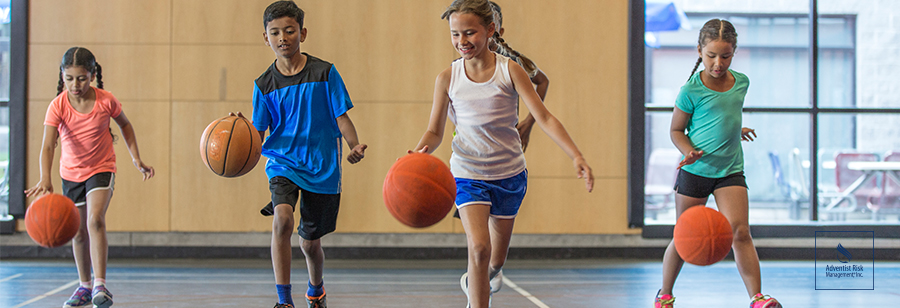When it comes to school sports and other physical activities, educators must be aware, understand and minimize the risks at hand.
Adventist Risk Management, Inc.’s claims counsel, Joseph Doukmetzian, explains how to handle accident and injuries on the playing field.What do I need to know in regard to liability during sports games or other sports activities?
Educators should be aware of the negligence cause of action. In the past 25 years, hundreds of student-athletes per year have filed suit against schools alleging some form of negligence. This is usually based on the theory that the school or its educators failed to safeguard the health and well-being of the student-athlete. These claims take many different forms, including, but not limited to:- inadequate supervision,
- failure to properly train,
- improper equipment or facilities,
- failure to warn of risks,
- failure to have an emergency medical plan,
- or improper medical clearance.
Risk can never be completely eliminated in inherently risky activities, such as athletics. However, there are three things that schools and educators should do in advance.
1. Educators should have a proper emergency medical plan in place.
This plan should detail the emergency personnel and their roles, the emergency communication methods, the necessary emergency equipment, the methods of emergency transportation, and a checklist of items that should be completed based on the location of the incident and severity of the injury. The emergency personnel and their roles are critical in the immediate care of the athlete. The first and most important role of the emergency personnel is establishing the safety of the scene and providing immediate care to the student-athlete. The emergency medical personnel should assess the injury, retrieve the appropriate emergency equipment, and if necessary, activate the emergency medical system by calling 911. Certifications in cardiopulmonary resuscitation (CPR/AED), first aid, prevention of disease transmission, and thoroughly reviewing the emergency plan is strongly recommended for all educators who are associated with athletic practices and competitions or are part of the emergency response team.2. Educators should have a proper concussion protocol in place.
This usually involves the education of student-athletes and athletics personnel on concussions, including appropriate recognition and diagnosis of concussions, and appropriate post-concussion management. All student-athletes should complete a pre-participation baseline concussion assessment at the start of the sports season.Society and science are beginning to understand how seriously concussions affect the neurological well-being and future of student-athletes. As of 2014, all 50 states and the District of Columbia have a “Return to Play” law that regulates concussion management in youth athletics. Most of these laws have three basic requirements: (1) any athlete suspected of having sustained a concussion must be immediately removed from play; (2) the athlete may not return to play the same day; and (3) the athlete may only return to play after written clearance is given by a licensed health care professional. Some of the state laws have additional requirements, such as completion of a concussion education course or that schools implement baseline testing for student-athletes. At a minimum, it is critical that educators have a concussion protocol in place that follows the laws of their respective state. However, from a risk management perspective, it would be a best practice for educators to create a concussion protocol that not only meets the requirements imposed by their respective state, but goes above and beyond. The CDC has a great website with plenty of educational information on concussions.
3. Educators should exercise proper care in treating injured student-athletes.
Appropriate supervision is a key area of exercising proper care to make sure the student-athlete receives complete care and is protected from further injury. Always make sure you have sufficient and adequately trained staff supervising the athletes. Is your school in line with state/province guidelines for interscholastic athletics set out for your area? If a student is injured, you must properly direct students to appropriate medical care based on their injuries. Lastly, establish safe facilities with regular inspections and repairing equipment when needed.What should I do if my student gets hurt during an official sports game on school grounds? What if the game is at another school?
The first and most important role of the educator or the assigned emergency personnel is establishing safety of the scene and immediate care of the athlete. Educators must always exercise proper care in treating student-athletes.In case of a student injury that occurs on school grounds in an official sports game, educators should follow the school’s established emergency medical plan or concussion protocol, depending on the injury. It is important that the person responsible for carrying out the emergency medical plan has adequate training (e.g. licensed athletic trainer).
In the case of a student injury that occurs off school grounds in an official sports game, the opposing school’s emergency medical personnel should provide care and the home team educators present can provide their assistance as best possible. For example, I’m a hockey fan and in professional hockey games, when there is a semi-serious or serious injury situation, both teams’ athletic trainers jump on the ice and rush to assist the injured player. The same principle should be adopted in sports injury situations with student-athletes.
What should I do if a visiting student gets hurt during an official sports game on school grounds? What if the game is at another school?
When the injury happens on school grounds, the educator still needs to exercise the same proper care to a visiting student-athlete as they would afford to their own student.In the case of an injury of a student-athlete from the other school on the other schools’ grounds, you as the educator owes no duty of care. The educator may still wish to offer their assistance to the opposing school’s emergency medical personnel. However, the educator should make sure to be careful during this process. While the educator owes no duty to the opposing student-athlete at the opposing school’s grounds, the educator could end up being liable due to their actions. In negligence, when a person has no duty of care to the injured but starts to treat, it triggers a duty of care to continue proper treatment. This opens the educator up to possible claims of medical malpractice or failure to observe, refer, or stabilize the injured player.
Here’s a simple chart to demonstrate, as an example, who would be liable and responsible to provide care depending on the location in which the injury occurred and the student who was injured:
What is the protocol if a student gets hurt on school grounds during a physical education (P.E.) class or recess/free time?
The short answer is that the protocol varies, depending on what plans the school has set in place. Fortunately, a lot of the same principles used in identifying a course of action in school competitive sports are applicable in a P.E. class or recess setting. When an injury occurs, the educator should always follow the emergency medical plan established by the school. In the event the school does not have an established emergency medical plan, the educator should establish safety of the scene and immediately care for and assess the injured student. Then the educator should contact the staff member designated to handle medical emergencies and call 911 or local emergency services, depending on the severity of the injury.Anything else I should know to protect my students and staff?
Schools have a duty to provide reasonably safe facilities and grounds to their students and student-athletes. Regular inspections of school facilities and grounds can expose potential problems and such problems should be corrected or repaired. Also, keep detailed records of the inspections as these records will serve you well if you have a claim or lawsuit against you.Schools and educators should have a policy for recording and communicating students’ medical restrictions. If a medical restriction exists, the school must honor and accommodate that restriction without a penalty.
The most important thing for educators to do is to make sure that their school has established a proper emergency medical plan and a proper concussion protocol. Above all else, the educator should exercise proper care in the treatment of any injury of any student.
For free materials on school inspections and creating an emergency plan, visit ARM’s School Safety page.


